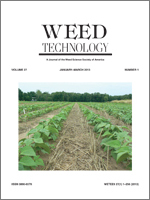Common bermudagrass is a problematic weed within tall fescue turfgrass. Field research was conducted from 2010 to 2012 in Knoxville, TN, evaluating the efficacy of sequential applications of topramezone (12.5 and 25 g ha−1), triclopyr (1,120 g ha−1), and mixtures of topramezone triclopyr for bermudagrass control in tall fescue turf. Sequential applications of fenoxaprop triclopyr (100 1,120 g ha−1) were included for comparison. Three applications of each treatment were applied at 21-d intervals during July, August, and September of 2010 and 2011. Plots were stripped to receive tall fescue interseeding at 0 or 490 kg ha−1 during September 2010 and 2011. Bermudagrass control with topramezone triclopyr mixtures was greater than topramezone or triclopyr applied alone 14 wk after initial treatment (WAIT) each year. In the second year of this study, topramezone triclopyr mixtures controlled bermudagrass 27 to 50% compared to 27% for fenoxaprop triclopyr by 52 WAIT. However, bermudagrass control with topramezone triclopyr mixtures increased to 88 to 92% by 52 WAIT when accompanied with tall fescue interseeding at 490 kg ha−1. Future research should evaluate effects of interseeding on the efficacy of different herbicides for weed control in cool- and warm-season turf.
Nomenclature: Fenoxaprop, topramezone, triclopyr, common bermudagrass, Cynodon dactylon (L.) Pers.; tall fescue, Lolium arundinaceum (Schreb.) S. J. Darbyshire.
Cynodon dactylon es una maleza problemática en el césped Lolium arundinaceum. Se realizaron investigaciones de campo entre 2010 y 2012 en Knoxville, TN, para evaluar la eficacia de aplicaciones secuenciales de topramezone (12.5 y 25 g ha−1), triclopyr (1,120 g ha−1), y mezclas de topramezone triclopyr para el control de C. dactylon en L. arundinaceum. Aplicaciones secuenciales de fenoxaprop triclopyr (100 1,120 g ha−1) fueron incluidas como comparación. Tres aplicaciones de cada tratamiento fueron realizadas a intervalos de 21 días durante Julio, Agosto y Septiembre de 2010 y 2011. Las parcelas fueron preparadas para recibir una entre-siembra de L. arundinaceum a 0 ó 490 kg ha−1 durante Septiembre 2010 y 2011. El control de C. dactylon con mezclas de topramezone triclopyr fue mayor que topramezone o triclopyr aplicados solos, 14 semanas después del tratamiento inicial (WAIT) cada año. En el segundo año de este estudio, las mezclas de topramezone triclopyr controlaron C. dactylon 27 a 50% en comparación a 27% con fenoxaprop triclopyr a 52 WAIT. Sin embargo, el control de C. dactylon con mezclas de topramezone triclopyr incrementó a 88 a 92% a 52 WAIT cuando estuvo acompañado por la entre-siembra de L. arundinaceum a 490 kg ha−1. Investigaciones futuras deberían evaluar los efectos de la entre-siembra sobre la eficacia de diferentes herbicidas para el control de malezas en céspedes de clima cálido y frío.





